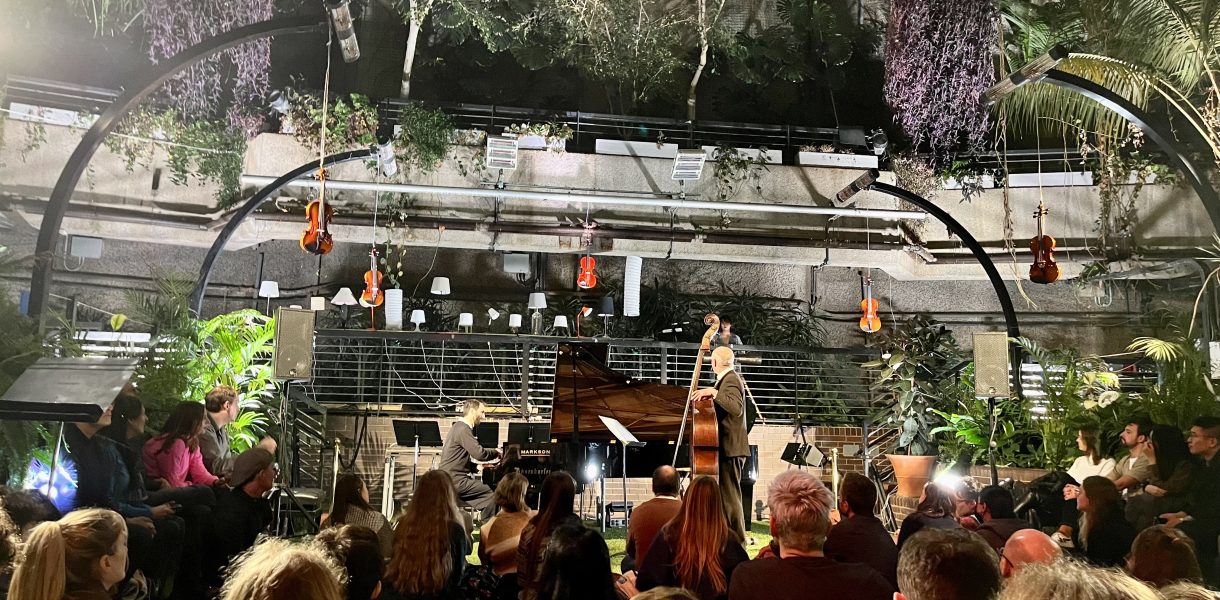Apocalypse Music co-founder Pia headed down to the Barbican Conservatory to watch the evening performance of “the greenhouse effect”, an immersive sound experience reflecting on our relationship with nature at a time of climate crisis.
I have long wanted an excuse to explore the Barbican Conservatory and this offering felt like the perfect opportunity. Through Natalia Franklin Pierce’s curation, “the greenhouse effect” explores how sound and listening can provide useful tools with which to think on and beyond the Anthropocene. And where better to ponder how we live with the world, as opposed to merely in it, than here: suspended within 2000 species of free-flowing greens which stand in such stark contrast to the Brutalist red brick of the surrounding Barbican estate.
Out of all the climate-themed sonic events I have recently encountered, this stands out as one of the most ambitious. I was captivated most at times when instruments or found objects were displaced from their traditional modes of being. Being immediately confronted with violins hung from cool metal pipes, for example, was pleasing yet incredibly haunting, as was the reveal of Claudia Molitor’s plastic covered piano which recalls the avant-garde work of Fluxus and climate-conscious artist, Annea Lockwood. Another crowd pleaser was Marcus Vergette’s handmade ocarinas in the shape of birds, which were buried like Easter eggs within the soil waiting to be unearthed. This became a simple but genuine celebration of one of nature’s most recognisable stimuli that the whole audience could interact with irrespective of musical background or understanding. While these moments delighted in the whimsical and the camp, others brought to our attention the severity of the climate crisis. The decision to open the evening performance with Marcus Vergette’s Tintinnabulation was a statement in itself, for the liberal use of heavy bells signalled a sombre death knell for the planet as we know it.

Each programmatic item was so diverse in terms of not only style but presentation that the overlying theme was sometimes lost. Marcus Vergette’s piece, although relevant conceptually, was lengthier and notably more virtuosic than the other pieces and I feel it would have benefitted from a stand alone outing earlier in the day. The layout of the venue also did not lend itself well to the mass movement of a large audience from one piece to another. At times, groups were all huddled around a single spot, with viewpoints being obscured and the finer sonic details consequently lost at a distance. One wonders how the overall ‘immersive’ experience would have differed had the pieces been performed simultaneously in a fluid, overlapping programme, to a smaller crowd who could move freely through the space and experience sounds in dialogue with one another, as opposed to following a strict concert order which speaks to a more conservative world.
nonclassical should be commended for showcasing the work of multiple climate-conscious interdisciplinary artists and performers at a time where the viability of the arts, our ensembles and our venues is such a contentious national issue. Following the release of the IPCC report earlier this week, a final warning on climate crisis given by the world’s leading scientists, there is no better time to reexamine our relationship with the natural world, and events like these give us accessible tools with which to do so. The Barbican Conservatory provides the perfect place to imagine, create and will one’s utopia into being, and I can’t wait for my next visit.
Words and image by Pia Rose Scattergood









